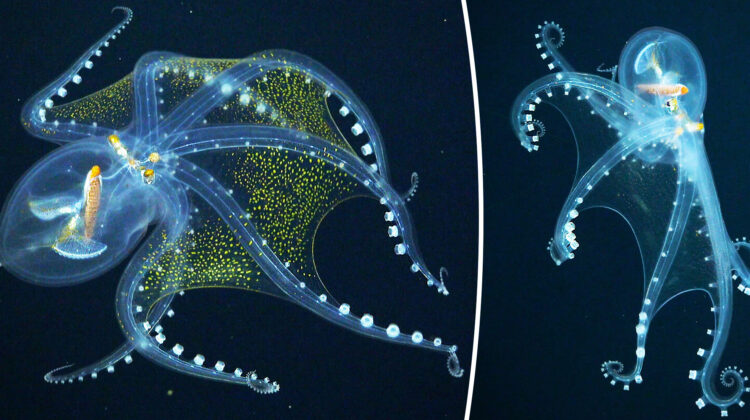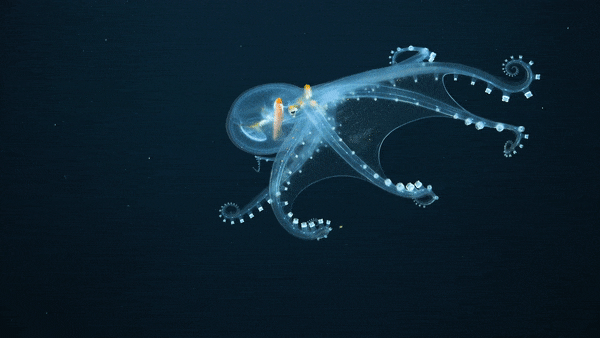
For over a century, the elusive glass octopus, also known as Vitreledonella richardi, has been one of the most enigmatic creatures of the deep sea. This ethereal creature has remained mostly elusive, and very little is known about it, except that it frequents subtropical and tropical areas deep in the ocean, mostly in the twilight zone and the midnight zone. Scientists have only been able to rely on specimens found in the gut of predators for past studies.

However, after a month-long survey, researchers have finally captured live footage of the glass octopus in the Pacific Ocean. This was the first time that scientists have been able to film the glass octopus with such clarity, thanks to the Schmidt Ocean Institute’s expedition. The researchers were exploring seamounts in the Pacific, covering over 30,000 square kilometers of the ocean floor.
The expedition team, which included scientists from the Woods Hole Oceanographic Institution and Boston University, used an underwater robot named SuBastian, which was operating from the research ship Falkor, to capture the footage. During the course of their voyage, the team encountered the obscure glass octopus twice.

The glass octopus is similar in appearance to other glass-like creatures like some comb jellies and glass frogs. It has only a few features that are opaque and clearly visible, including its eyeballs, digestive tract, and optic nerve. Its eyes have developed to present a minimal silhouette, helping it to camouflage itself.
In addition to the glass octopus, the team also captured footage of the whale shark for the first time. They were also able to witness the unusual behavior of other marine creatures, such as crabs stealing fish from other crabs. The research team made a total of 21 expeditionary dives, totaling exploration of 182 hours deep under the ocean and on the seabed.

The live-streaming of the dives gave researchers a rare and invaluable glimpse of the rarely sighted glass octopus, along with other mysterious creatures lurking in the depths of the Pacific Ocean. The footage will help researchers in furthering their knowledge of such creatures and prepare them for protecting them in the future in their natural habitats.
According to Executive Director Dr. Jyotika Virmani of the Schmidt Ocean Institute, the marine scientists collaborated with local researchers and scientists to map the seafloor with high-resolution cameras and conduct a video exploration of five more seamounts. The institute was founded by former CEO of Google, Eric Schmidt, and Wendy Schmidt, who co-founded the institute.

Wendy Schmidt said that the ocean conceals much more than we can even imagine, much less discover. She said that such thorough expeditions teach us the need to ramp up our efforts to better understand and restore the complex marine ecosystem all around the planet. A better understanding of the ocean and the creatures that live in it holds the key to human well-being and health, as life originated in the depths of the ocean.

Spectacular images—thank you!
One touch of its arm will rip the hide off Ya
Nature is astounding.
Incredible. Thank you for sharing.
Nothing to hide as you can see my 8 astanga limbs.
Below the stress above the waters We exist.
We are Aii Interconnected Beings
How do I purchase the octopus
Thanjs for sharing this. Absolutely Awesome!
So beautiful and exciting!!!!
Superb quality photography – it brings my mind to a point of imagination, such fantastic creatures. Thank you for sharing your experiences.
Evolution is remarkable
Beautiful Earth
What a beautiful animal!
I think the article meant to say “the world largest fish” not “animal”, about the whale shark.
Astonishing! A reminder that our known environment is still so restricted that we could be compared to moles however impressive our recent insights into the far away Cosmos thanks to the J. Webb telescope or the deepest recesses of our own biosphere.
Sharks aren’t animals, they’re fish. The largest animal is the blue whale. Important to get these things correct when discussing such important and educational topics. Stunning photos.
Fish and mammals are both animals. The whale shark can grow up to 39 feet long, but the blue whale can reach 70-90 feet long.
hate to break it to you, but fish ARE animals. It’s important you get these things right when you criticize people who are much smarter and less sarcastic than you!
Tut,tut, tut! Animal, vegetable, or mineral three categories. Take your pick. Raymond
Question of interest to me is the longevity of earth; what is earth-life? The age has not given an answer with certainty .
The oldest rock on our planet dates earth – age at about 4 billion years old. The rock is on the northern -most part of the Norwegian coast.
Great article, but for clarification the whale shark is not the worlds largest living animal, but the largest non mammalian vertebrate
Do glass octopus have the ability to mimic color & texture like more common types?
Amazing! There are probably thousands of creatures in the deep as well as in Amazon forest to be discovered
You are correct, the whale shark is a fish. The whale shark isn’t a true whale; it’s just named that because of it’s large size. The blue whale 🐳 is larger.
What is the size of that beautiful octopus?